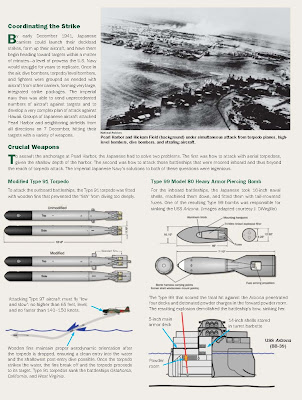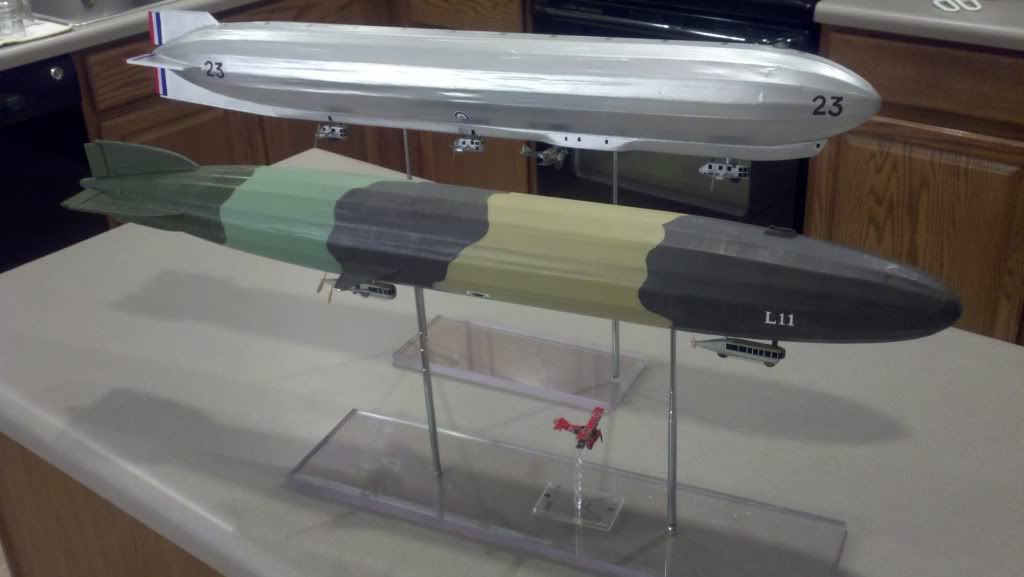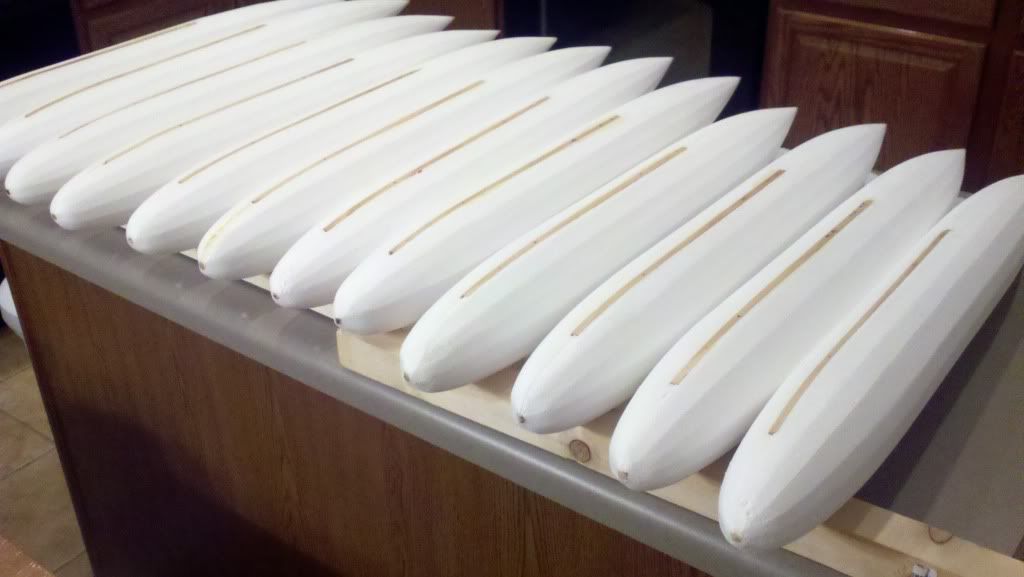If I could only do it all over again . . . Oh I can? Cool. Here is the deepest delve into my madness.
Remember the "Building Dirigibles" thread, I got a lot of mail and great responses, but the models were a month of hard work and the end result while very cool, were not as durable as I had wanted. The search began for the ultimate Zeppelin. After kicking around ideas from vacuum molding to casting, I re-discovered a technique I had used to build foam wings for control line stunt models I had used back in the 70's.
Foam is a strange beast, very different formulations and ever greater ranges of density and workability. I had hoped to find the old blue, pink or gray 2" styrene sheet of yesterday and found out it is not available here. In desperation I made a personal visit to the home construction mega mart, only to not find what I wanted. Instead I found something better. Out here in the desert of Arizona most houses are made of plywood with stucco finish and trim. They use a foam billet for trimming around the windows made of a high density expanded bead styrene. It comes in strips instead of sheets, and to my delight in 2" x 4" x 96" strips. This is not your normal foam, it is quite hard and if cut with a 400 degree nichrome wire, it seals itself into a perfect medium for our purposes here. So I bought a pile of it.
Now to make it happen. I routed a 1/4" groove lengthwise and chopped the chunks to length, routed a keel slot in each one, installed a dowel to the groove, slathered both sides with glue and started stacking them in the corner. Added a lot of weight and went to bed.
After a night of tossing and turning the next step through my dreams, I awoke and began constructing the cradle, guides, rotary indexer device, and a foam cutter. The concept and design are very simple and straight forward. The foam block is now 4" x 4" X 30" long with a 1/4" dowel running its length through its center. This core is then suspended between two end plates allowing the core to be rotated a few degrees at a time. Meanwhile the sides of the fixture are cut to the side profile of the final zeppelin, lined with steel wire to keep the shape consistant and to prevent the hot wire from burning into the profile.
The foam cutting frame is built with a capacity to handle the 400 degree heat and the normal heat expansion of the wire. Once connected to my power source, the wire is heated and tested for a nice clean cut. The cutting frame is then drawn along the steel guides of the fixture the length of the foam core, cutting it to a nice half zeppelin shape! Way cool.
The core is then rotated the required degrees of angle and the process is repeated 16 times. Producing a cool foam corn dog!
A keel is required to attach the mounting poles and the nacelles. Again the router cut a nice groove down the belly of the beasties and a 1/4" spruce strip was pre-drilled and inserted into the foam.
A final sand, a coat of polyacrylic and the hull is done! Fast, freaky fast.
Fins, gun emplacements, all the details were fabricated, and a fixture designed to align and attach them.
Nacelles were redesigned to attach with mini magnets and steel pins so they can be removed for easy transport.
All that is left is painting and detailing! That's all . . .
The results you can see, rugged, transportable, playable! These babies can be dropped, poked and prodded and survive to fight another day! Enjoying my madness?
Whew! Now it's time to raid England! Operation Zeppelin Overcast begins!"
From clipper the great !
28/02/2012
Libellés : dawn of war, wings of glory
25/02/2012
Thanks to "aerodrome forum" :)
Bombardiers bi-moteurs prévus pour la série 1 : on devrait voir arriver cette année les Henkel He.111 et North American B-25 Mitchell, chacun portant 2 couleurs différentes.
Les règles seront complétées pour ces caractéristiques.
Henkel He.111
Libellés : dawn of war, figurine avion
22/02/2012
Quelques images d'un SE5A. Une vieille bobine argentique, retrouvée par hasard dans une grange de Lorraine...
Libellés : figurine avion, Wings of war
19/02/2012
HMGS/PSW pulls off its first convention of 2012 “Winter Campaign”http://www.hmgspsw.org/
Ces américains sont GRANDS ! jetez un coup d'œil a leur blog, les tables de jeux sont vraiment impressionnantes ... des combats navals, aux actions tactiques de la seconde guerre mondiale, en passant par les guerres d'indépendance ou napoléoniennes...
Libellés : historical
Libellés : dawn of war, guerre mondiale, historical
18/02/2012
Libellés : dawn of war, guerre mondiale, historical, propaganda
17/02/2012
Libellés : dawn of war
12/02/2012
wings of glory for WWI and WWII. Nouveau design proposé par le nouvel éditeur Ares.
To make easy to get started on WW1 Wings of Glory, Ares Games will release a Rules and Accessories Pack that will include everything needed to start playing the WW1 version of the game system. Airplane miniatures are not included, however - the pack must be combined with two or more Airplane Packs or Special Packs - each featuring a miniature and its maneuver deck - or with a Starter Set.
Players will find all WW1 rules – Basic, Standard, Advanced, Optional and the ones to use with models, such as multi-engine bombers and balloons, and weapons (rockets and incendiary bullets). The pack will also feature four decks of Damage Cards (A, B, C, D), Target, Trench, Machine Gun, Anti Aircraft Guns and Bomb cards, four airplane consoles, two rulers and counters.
“We decided to publish this Rules and Accessories Pack to provide a complete starting point to our range. This will benefit both new players and those fans who already own miniatures and sets from the ‘Wings of War’ brand. This compendium combines all existing rules of the WW1 game system, as well its cards and counters. Gamers will be able to start playing with the first WW1 Wings of Glory release, the Bombers Special Packs, and also to play with all the Airplane Packs and Special Packs that will come in the future. The rules are also compatible with all the existing Wings of War products that players already own”, said Christoph Cianci, CEO of Ares Games.
dates :
The Rules and Accessories Pack will be released in April, just after the arrival of the Bombers Special Packs (Caproni Ca.3 and Gotha G.V). The first WW1 Wings of Glory Airplane Packs are planned to be available at the same time as the Rules and Accessories Pack, and will feature the models Fokker E.III, Halberstadt D.III, Morane-Saulnier and Airco D.H.2.
Wings of Glory WWII new design box :
Libellés : dawn of war, wings of glory, Wings of war
03/02/2012
Incredible Dirigible...from aerodrome forum.
Libellés : figurine avion, Wings of war












































